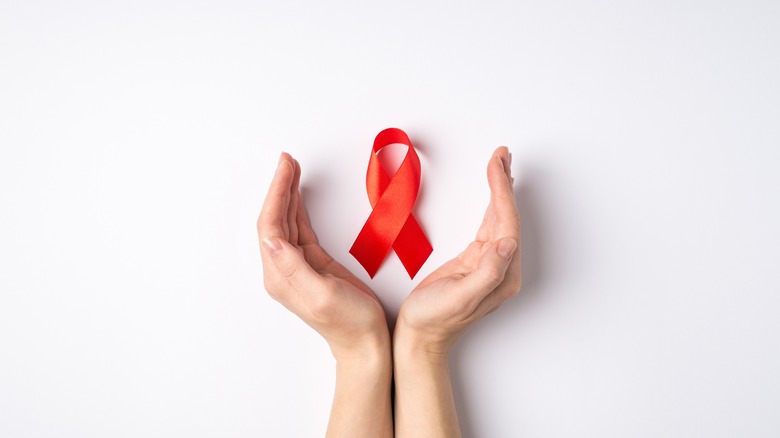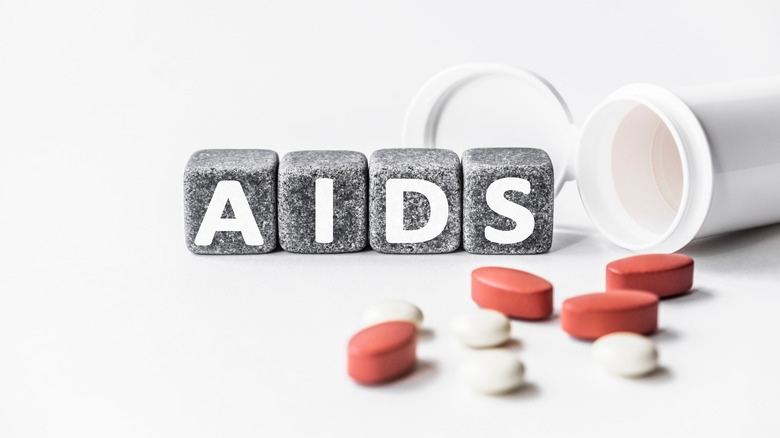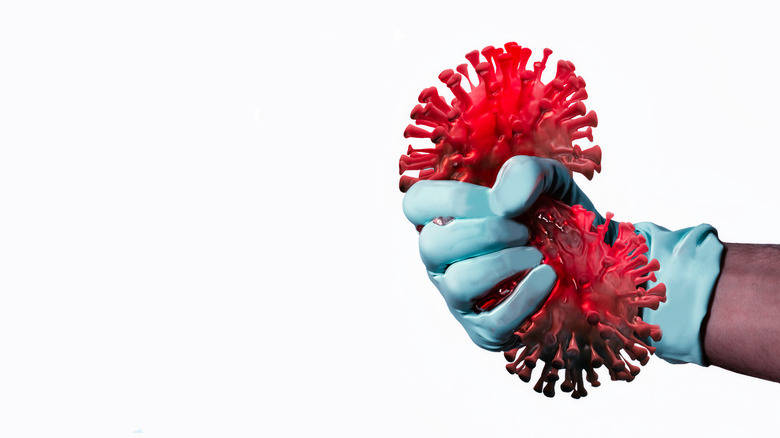How HIV Affects Different Parts Of Your Body
HIV stands for human immunodeficiency virus (via HIVinfo). It is the virus that causes HIV infection, but the acronym "HIV" is also used to describe the disease itself. It is spread from one person to another through contact with infected bodily fluids like blood, semen, vaginal secretions, rectal fluids, and breast milk. Most commonly, HIV is acquired through anal or vaginal sex (without a condom or being on medication that prevents or treats HIV) or by sharing needles or syringes with someone who has HIV. It is not transmissible through hand-shaking, hugging, or contact with the same objects like doorknobs, toilet seats, and dishes.
According to Britannica, HIV can be traced back as far as the late 1800s in Africa. By the mid-1960s, it had evolved and spread from Africa to Haiti. There, it underwent further modifications and reached the United States sometime between 1969 and 1972. On June 5, 1981, the Centers for Disease Control and Prevention (CDC), reported the first cases of HIV infection in the U.S., though it was not identified as such in the initial case reports (via CNN). What the CDC noted was that five fairly young gay men in Los Angeles, who were strangers to one another and didn't appear to share a common social group, were treated in separate hospitals for an uncommon lung infection that would typically only be seen in immunocompromised people. Two of the five had died.
The World Health Organization (WHO) reports that over 84.2 million people in the world have been infected with the virus, and close to 1.2 million people in the U.S. have the disease as of 2020 (per the CDC).
Stages of HIV
The first stage of HIV is acute infection, which can occur within two to four weeks following exposure to the virus, and can last for a couple of weeks (via HIVinfo). A person may experience nonspecific symptoms such as fever, headaches, sore throat, muscle aches, and a rash. Although the symptoms are mild, people are highly infectious because the virus is multiplying and spreading rapidly throughout the body, which means that the amount of HIV circulating in the blood and other fluids is very high.
The acute phase of the disease is often followed by the second stage — chronic HIV infection. During this time, the virus is still replicating, but at a slower rate compared to the first stage. Because of this, symptoms are usually minimal or absent, but the virus remains transmissible. As its name suggests, the second stage can last a really long time. Specifically, a person can remain on this stage for around 10 years without treatment, or several decades with treatment. If the disease is controlled well enough, some people may never advance to the third stage, which is AIDS (per Medical News Today).
AIDS (acquired immunodeficiency syndrome) is a life-threatening condition where the burden of HIV in the body is extremely high, but the number of immune cells is extremely low. A person is highly infectious and very susceptible to infections and other diseases during this time (via WebMD). Without treatment, death is expected to occur within about three years.
HIV and the immune system
A 2012 paper from Clinical and Developmental Immunology explains that the immune system is made up of specialized cells and organs that function to screen antigens (i.e., substances in cells that trigger an immune response) inside the body, and determine if they are harmful or not. Harmful antigens, such as those found in foreign pathogens like viruses, are eliminated from the body, while non harmful antigens are left alone. The immune system also creates a copy of these antigens so that it can respond faster the next time it encounters them.
The CD4+ T cell (e.g., helper T cell, regulatory T cell) is one of the specialized cells of the immune system. They coordinate the body's response to infections. A review published in Frontiers in Immunology states that HIV takes advantage of this mechanism by infecting CD4+ T cells — which causes the cells to die and subsequently lowers the body's immune response — or by fusing with uninfected CD4+ T cells, which leads the virus to spread from one cell to another.
Eventually, the body becomes deficient in immune cells and more prone to bacterial, viral, fungal, and parasitic infection (per MedlinePlus). Infections like the flu that usually go away on their own in a healthy person become harder to treat in people with HIV or AIDS, and are more likely to progress and develop complications.
HIV and the cardiovascular system
Individuals with HIV are at an increased risk of developing heart disease (via WebMD). The reason behind this is still unclear, but researchers believe that it may have something to do with the widespread inflammatory state that happens when you have HIV. Plaque buildup in the walls of the arteries occurs at a much faster rate, leading to impaired blood flow, which increases the risk of heart attacks, strokes, irregular heart rhythms, heart failure, and heart valve problems.
Researchers at Johns Hopkins Medicine also found that even without the presence of plaques, the coronary arteries (vessels that supply the heart with blood) of people with HIV react to stress the same way as they would in people with severe heart disease. This suggests that HIV itself causes the heart to respond abnormally, outside of the usual mechanism seen in people without HIV who have problems with their heart.
HIV and the digestive system
According to an article published in the journal American Family Physician in 2011, HIV can affect almost all parts of the digestive system, including the mouth, esophagus, stomach, intestines, pancreas, and liver.
Oral and esophageal infections are often caused by Candida, cytomegalovirus, or herpes simplex virus. These pathogens can cause thrush infections, canker sores, plaques on the tongue or inside the mouth, gum disease, and inflammation in the upper digestive system (via Colgate), which lead to symptoms like difficulty swallowing, pain with swallowing, and chest pain. There is also an increased risk of oral cancer in people with HIV, especially if they smoke, drink alcohol, or have an oral human papillomavirus (HPV) infection.
In the stomach and intestines, a type of cancer called lymphoma can grow, which is caused by HIV activating the immune cells in the lining of the digestive tract (per the Cancer Treatment Centers of America). Diarrhea is also common, often caused by infections and inflammation (per American Family Physician). Likewise, swelling of the pancreas leads to pancreatitis, and this is most commonly due to side effects of HIV treatment, although infections are also to blame. Inflammation of the liver, or hepatitis, is now one of the most common causes of death and morbidity in people with HIV, and it can be caused by viral infections like hepatitis C, or nonviral conditions like nonalcoholic fatty liver disease.
HIV and the musculoskeletal system
Joint pain is common in HIV, but not everyone will experience it, and the severity can vary from one person to another. Some may only have mild pain, while others may have pain that becomes more frequent and more severe. According to WebMD, HIV increases a person's risk of developing certain types of arthritis, including gout, rheumatoid arthritis, reactive arthritis, and psoriatic arthritis. These present as pain, redness, and swelling in joints such as in the knees, ankles, shoulders, elbows, fingers, and back.
Medical News Today adds that when a person with HIV has progressed to AIDS, they may experience HIV wasting syndrome — a complication that manifests as unintended weight loss of more than 10% of body weight, fever, weakness, and prolonged diarrhea lasting more than a month. The causes of wasting include impaired absorption of nutrients due to diarrhea and gastrointestinal infections; insufficient food intake caused by lack of appetite, mouth or throat infections, or decreased energy; and changes in hormone levels and metabolism. All of these factors can bring about loss of muscle and fat mass, resulting in an increased risk of osteoporosis, falls, and fractures.
The U.S. Department of Veterans Affairs (VA) advises people with HIV to increase their intake of calories and protein to prevent wasting. This can be done by adding certain types of food to your diet such as peanut butter, legumes, and eggs. Exercise can also help maintain or increase muscle mass, especially weight-bearing exercises and resistance training.
HIV and the nervous system
HIV infects and replicates in numerous cells in the body, including microglial cells — specialized immune cells that are part of the central nervous system, and which help to keep the brain healthy (via Neuron Glia Biology). Authors of a 2019 article published by Frontiers in Cellular and Infection Microbiology explain that microglial cells regenerate and divide very slowly and have an average lifespan of 4.2 years. This characteristic gives HIV plenty of time to spread from one cell to another, and persist in the nervous system throughout a person's life. Microglial cells serve many functions, including removal of foreign pathogens, dead cells, and unnecessary substances. They also play an important role in processes that make sure that the central nervous system (i.e., brain and spinal cord) is working properly. Because of this, infection of microglial cells by HIV can damage them and cause accelerated brain aging, and predispose a person to developing neurodegenerative diseases like Alzheimer's disease, Parkinson's disease, and amyotrophic lateral sclerosis (ALS).
The National Institute of Neurological Disorders and Stroke adds that when the central nervous system gets infected by HIV, people may experience headaches, confusion, memory problems, changes in behavior and mood, poor concentration, and impaired coordination and movement. The peripheral nervous system can also get infected, and this manifests as progressive weakness and decreased sensation in the upper and lower extremities. In children, developmental and growth delays may also occur.
HIV and the respiratory system
The nose, sinuses, throat, windpipe, and lungs are all part of the respiratory system. WebMD states that one of the most common respiratory symptoms of HIV is coughing, frequently due to infections. The cough can be dry, but sometimes it can also be phlegmy. Although having HIV increases a person's risk of acquiring other infections, factors such as age, smoking, and drug use can also lead to respiratory symptoms. Infections like sinusitis or bronchitis can happen to anyone, but in people with HIV, these infections are usually more severe, persistent, and difficult to treat. HIV also increases a person's risk of developing opportunistic infections — illnesses that rarely occur in healthy individuals — in the lungs and elsewhere in the body.
According to Medical News Today, other things that can cause respiratory symptoms in people with HIV include cancer, acid reflux, being in cold air, and the presence of other unrelated respiratory diseases like asthma or chronic obstructive pulmonary disease (COPD). Aside from coughing, other respiratory symptoms may include shortness of breath, production of phlegm, chest pain, difficulty breathing, and coughing up blood.
HIV treatment can prevent serious breathing problems and other complications, which is why it is important for people with HIV to consistently take their medications and have regular checkups.
HIV and the eyes
Several eye problems can occur in people with HIV. Depending on the cause and how severe the condition is, they may experience blurry vision, seeing double, changes in color vision, seeing spots or floaters, flashing lights or light sensitivity, pain, watery eyes, and possibly vision loss. According to Preventing Blindness, the most common eye condition in people with HIV is HIV retinopathy, a disorder where blood vessels that supply the retina get blocked or bleed.
CMV retinitis and herpes zoster ophthalmicus (HZO) are other eye conditions often seen in those with HIV. CMV infects the retina and may cause it to detach from its normal position, especially if it is left untreated. On the other hand, HZO is caused by reactivation of the virus that causes chickenpox, and presents as painful blisters on the face and around the eyes. Other less common pathogens that can infect the eye include Candida, syphilis, herpes simplex, gonorrhea, and toxoplasma.
Kaposi sarcoma is a type of cancer that develops in the lining of blood vessels and lymphatic channels (via Mayo Clinic). Painless, purple spots can grow on the eyelids, the white part of the eyes, and other areas of the body. Those with HIV are more likely than others to develop this kind of cancer. NVISION adds that dry eyes, squamous cell carcinoma of the eyelid, and immune recovery uveitis (IRU) can also be seen in those with HIV. IRU, an inflammatory reaction in the eye, occurs in people who are undergoing HIV treatment, and interestingly tends to happen once their immune system function has improved.
HIV and the skin
HIV increases a person's risk of developing many dermatologic conditions. According to Healthline, dermatitis is the most common symptom of HIV. There are many forms of dermatitis, but some that are commonly seen in people with HIV include xerosis (scaly patches that itch), atopic dermatitis (an inflammatory condition that causes red, dry, and itchy skin), seborrheic dermatitis (dry, itchy skin on the face and scalp that causes dandruff in adults and cradle cap in infants), photodermatitis (increased sensitivity to UV rays), eosinophilic folliculitis (itchy, red bumps on hair follicles of the scalp and upper body), and prurigo nodularis (itchy lumps on the arms and legs). People with HIV are also at risk of developing warts caused by HPV, as well as skin cancers.
Additionally, infections like molluscum contagiosum can be seen in HIV (via Johns Hopkins Medicine). This is a virus that spreads via skin-to-skin contact, and which causes bumps to form on the skin. Anyone can get infected with this condition, but people with HIV are more likely to experience a prolonged, persistent, and more severe form of the disease.
HIV and pregnancy
The American College of Obstetricians and Gynecologists states that HIV can be passed from mother to baby during pregnancy via the placenta. It can also happen during labor and delivery if the baby is exposed to the mother's blood or other fluids, as well as through breastfeeding. However, this does not mean that women with HIV cannot have children. You can minimize your risk of transmitting HIV to your baby by following the recommendations provided by your doctor. Depending on how well-controlled your infection is, you may need to take a specific combination of drugs throughout your pregnancy and during labor and delivery, have a cesarean section, give antiviral drugs to your baby after they are born, and/or avoid breastfeeding.
If you do not have HIV but your partner does, and you are planning to have a baby, the Office on Women's Health recommends that you speak with your doctor about what medicines you can take or what methods of assisted reproductive technology you can use to minimize your and your future baby's risk of acquiring the infection. The risk can be reduced, but unfortunately, there will always be a chance of transmission.
Babies who get HIV from their mother through childbirth or breastfeeding (i.e., congenital HIV) will initially have no symptoms, but will gradually develop complications as the virus multiplies and spreads throughout the body. According to Nicklaus Children's Hospital, infants and children may experience lack of energy, weight loss, fevers, chills, infections, skin rashes, and delays in developmental milestones, among other things.
HIV and mental health
According to the National Institute of Mental Health, people with HIV are at an increased risk of developing mental health conditions. Stigma and discrimination play a role, but other factors contribute to it as well, such as having limited access to mental health services, the burden of medical treatments for HIV, the dread of having to disclose their diagnosis, losing or having no social support, fear of losing their job or worry about their diagnosis affecting their work performance, and losing relationships or experiencing loss of a loved one due to HIV. Antiretroviral medications used to treat HIV can also sometimes cause or exacerbate the symptoms of mental health issues (per HIV.gov).
Depression is the most common mental health condition experienced by people with HIV. Symptoms include changes in sleep patterns, loss of interest, feelings of guilt or worthlessness, low energy, difficulty concentrating, change in appetite, agitation, and having suicidal thoughts. It's vital to remember that mental health conditions can be treated, and that if you're experiencing any of these symptoms, you should reach out to your healthcare provider.
If you or someone you know needs help with mental health or is having suicidal thoughts, please contact the Crisis Text Line by texting HOME to 741741, call the National Alliance on Mental Illness helpline at 1-800-950-NAMI (6264), visit the National Institute of Mental Health website, or call the National Suicide Prevention Lifeline by dialing 988 or by calling 1-800-273-TALK (8255).
HIV treatment
HIV is treated using antiretroviral therapy (ART) — a combination of drugs that target different parts of the virus to stop them from replicating and spreading (via HIVinfo). By doing so, the viral load will decrease, and the immune cells will be able to produce more CD4+ T cells to help fight off the infection. Although there is no way to completely rid the body of HIV, ART can reduce its viral load to undetectable levels, which reduces the risk of transmitting the virus to almost zero.
There are seven different classes of HIV medicines, and they are usually taken in certain combinations. Treatment regimens differ for each person, and are dependent on many factors like potential side effects, interactions with other drugs you are taking, and whether they effectively reduce your viral load or not.
HIV.gov states that aside from ART, people with HIV should also get vaccinated, since their bodies need all the protection they can get to fight off infections. Recommended vaccines for people with HIV include COVID-19, hepatitis B, HPV, influenza, meningococcal series, pneumococcal, and DTaP (diphtheria, tetanus, pertussis).
Effects of HIV treatment on the body
The medicines that treat HIV come with many side effects — but it is important to know that treatment regimen are vital to improve the quality and length of life for those with HIV, and to help prevent transmission to others (via HIVinfo). Side effects of treatment can range from mild to severe. Common side effects include loss of appetite, nausea, vomiting, diarrhea, lipodystrophy (simultaneous loss of fat and fat deposition in certain areas of the body), lack of energy, dry skin or rashes, difficulty sleeping, mood changes, and increased levels of cholesterol and triglyceride in the blood (via Healthline).
The VA adds that headaches and dry mouth are also common, and that many of these side effects typically get better after a week, and can effectively be managed through diet, exercise, and proper sleep. However, if you are experiencing sudden changes in symptoms, or persistent side effects, it is important that you speak with a doctor right away, as these can be a sign of another potential health issue like an infection.
According to WebMD, more severe side effects that can happen with HIV treatment include hypersensitivity reaction (allergic reaction to a drug that can be life-threatening if it is not stopped immediately), lactic acidosis (overproduction of lactic acid), high blood sugar, and liver damage.
Living with HIV
The Palliative Care Network of Wisconsin reports that people with HIV who are compliant with their treatment are now living almost as long as the general population. In the past, death in people with HIV was often caused by infections or HIV-related complications. But because of improved care and early initiation of ART, death rates continue to decrease across all ages, genders, and racial and ethnic groups (via the CDC). Today, the causes of death in people with HIV have shifted to organ failure, non-AIDS malignancies, substance abuse, and limited access to health care.
If you have been diagnosed with HIV, Medical News Today advises you to seek medical care and begin ART immediately. Having regular checkups and adhering to your treatment is your best chance at managing the disease. Unfortunately, it can be challenging and expensive to find quality care. The CDC has a list of resources that can help you find what you need, along with other useful things like financing, housing and job opportunities, legal issues, and mental health programs. The Ryan White HIV/AIDS Program also has a list of hotlines per state that you can use to get support.
Research is continuously being done on HIV, and we have come a long way compared to where we were 40 years ago. Scientists are looking into a very small subset of people with HIV who are able to control the virus without treatment (aka "elite controllers"), hoping to find a cure (per ScienceNews).















